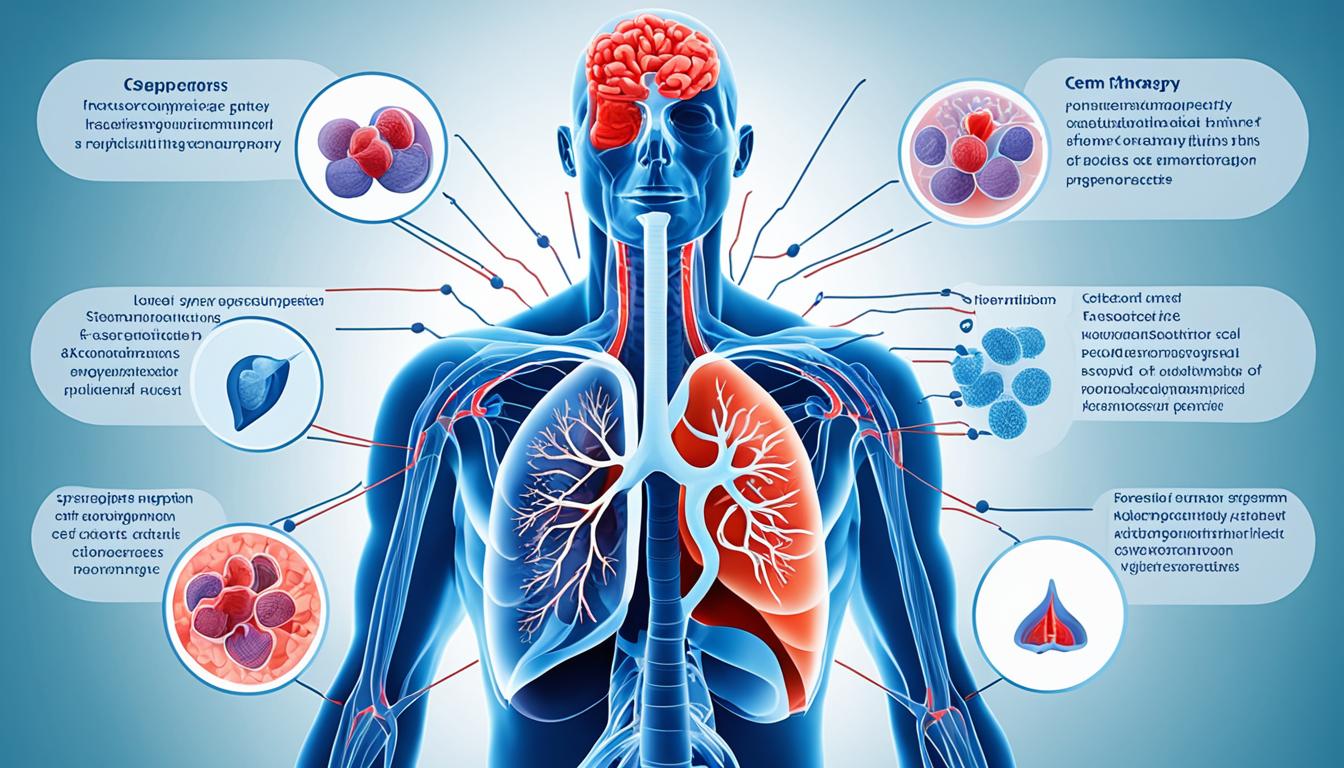Pulmonary hypertension (PH) causes high pressure in the arteries of our lungs. It is a serious disease that must be treated. Doctors diagnose PH when the pressure in our lung arteries gets too high. The reasons behind PH aren’t always clear. But, it could relate to genes, inflammation, or other health issues. People with PH feel short of breath, have chest pain, get tired easily, and their legs swell. To find out if someone has PH, doctors check their symptoms, medical history, and do some tests like an echocardiogram. They might also do a cardiac catheterization.
Treating PH helps reduce symptoms, makes life better, and slows the disease. Options include drugs, life changes, and surgery. Now, scientists are looking into stem cells as a new way to treat PH. Research has shown good results so far.
Key Takeaways:
- Pulmonary hypertension (PH) is a condition characterized by elevated pressure in the pulmonary arteries.
- Common symptoms of PH include shortness of breath, chest pain, fatigue, and swelling in the legs.
- Diagnosis involves a thorough evaluation of symptoms, medical history, physical examination, and diagnostic tests.
- Treatment options for PH aim to alleviate symptoms, improve quality of life, and slow down disease progression.
- Stem cell therapy is being explored as a promising treatment option for PH, with positive results in studies.
Standard Treatment Methods for Pulmonary Hypertension
Pulmonary hypertension (PH) is a challenging health condition that needs a full treatment plan. This plan includes both medicine and lifestyle changes. The goal is to ease symptoms and slow down the disease.
Medications are key in PH treatment. They help lower blood pressure and make the patient feel better. Doctors often recommend the following drugs:
- Thiazide diuretics
- ACE inhibitors
- Calcium channel blockers
- Vasodilators
It’s crucial to mention that not all people will respond the same way to these drugs. Plus, they might cause side effects. Because of this, scientists are looking into other treatment options.
One exciting area is stem cell therapy. It might offer a new approach to PH treatment. This therapy works by using the body’s own stem cells to repair damaged blood vessels, helping them work better.
Stem cell therapy has some big benefits:
- Inflammation reduction: MSCs are anti-inflammatory and can help tone down inflammation linked to PH.
- Promoting angiogenesis: They also boost the growth of new blood vessels. This makes blood flow better and lowers heart strain.
- Weight loss: In addition, they might help with losing weight. This is vital for lessening heart pressure in PH.
You can get these beneficial stem cells from either your own body or a donor. Once obtained, doctors put these cells into you, either by IV or locally, depending on your medical condition.
Studies have found promising results with stem cell therapy in PH. People have seen better blood pressure, fewer symptoms, and improved outlooks on their health.
However, more research and clinical tests are necessary to fully prove how well and safe stem cell therapy is for PH treatment.
Treatment Options for Pulmonary Hypertension
Here’s a table that outlines the usual treatment methods for pulmonary hypertension:
| Treatment | Description |
|---|---|
| Antihypertensive drugs | These medicines like thiazide diuretics, ACE inhibitors, and others, help lower blood pressure and improve PH symptoms. |
| Stem cell therapy | A regenerative medicine that uses MSCs to boost healing, reduce inflammation, and encourage weight loss. This helps the vessels damaged by PH to function better. |
| Lifestyle modifications | Essential lifestyle changes include diet alterations, regular exercise, quitting smoking, and managing other health problems. These changes are important for handling PH and enhancing overall well-being. |
| Surgical interventions | If PH is very severe, surgeries like pulmonary thromboendarterectomy or lung transplant might be seen as potential treatments. |
Working closely with healthcare providers is crucial for people with PH. Together, they can make a personalized treatment plan that meets the patient’s specific needs and goals.
Conclusion
Pulmonary hypertension is a complex and progressive disease. It needs careful treatment. The main ways to treat it include medicines and changes in how you live. These methods help to reduce symptoms and slow the disease down. Yet, they might not work for everyone.
Another option to consider is stem cell therapy. This therapy shows hope for people with pulmonary hypertension. It uses stem cells to fix damaged blood vessels and lower swelling. It also helps people lose weight. Stem cell therapy is a new and exciting way to treat this illness. It could really change how well people do and how they feel.
We still need more study and tests to know if stem cell therapy is truly helpful and safe. But the first results are optimistic. They give us hope and show a future where treating pulmonary hypertension is better for those with the disease.

